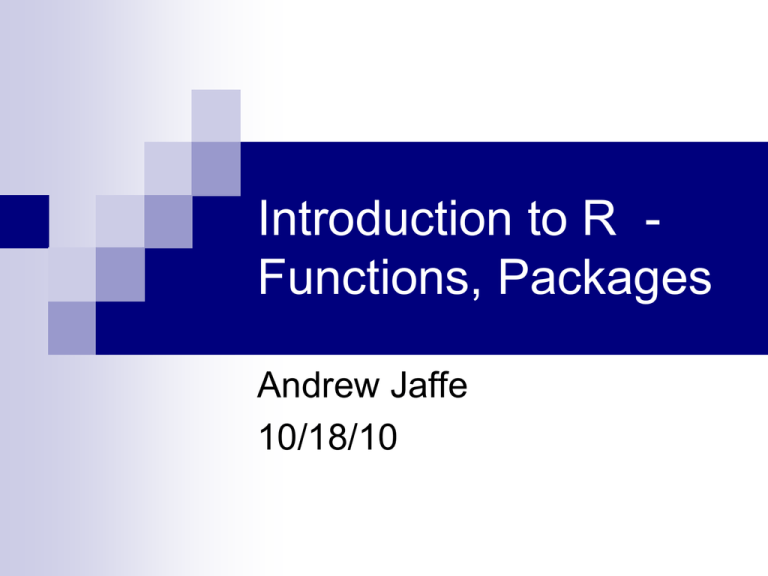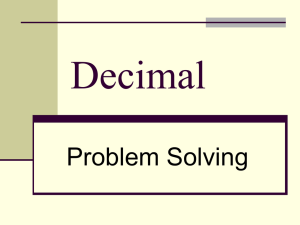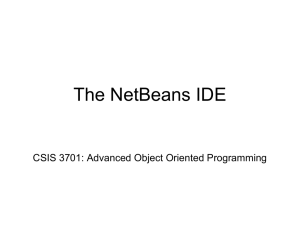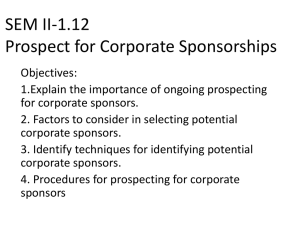Lecture 7
advertisement

Introduction to R Functions, Packages
Andrew Jaffe
10/18/10
Overview
Functions
Packages
Questions
Functions
Everything you use in R is a built-in
function
You can download new functions
(packages – next section)
You can add your own to a script
Functions
Built in functions (note the lack of
parenthesis – this is also why you don’t
want to name variables as functions):
> rep
function (x, ...) .Primitive("rep")
>c
function (..., recursive = FALSE)
.Primitive("c")
Functions
Syntax: functionName <- function(inputs) {
body of the function which returns
something}
You must run/submit the function before
you can use it
Note that variable naming within a function
is protected, and not altered by whatever
your script is doing
Functions
Input
# tests if a number if positive
pos = function(x) {
if(x >= 0) out = 1
if(x < 0) out = 0
return(out)
}
Output
Functions
Run the
function
first
> pos = function(x) {
+ if(x >= 0) out = 1
+ if(x < 0) out = 0
+ return(out)
+ }
> pos(5)
[1] 1
> pos(-5)
[1] 0
Functions
The value that the function returns can be
stored as a new variable
> y = pos(4)
> y
[1] 1
Functions
> # protected – x is the
# input to pos
> x = 3
> pos(6)
[1] 1
> x
[1] 3
Functions
Using return() explicitly tells the function
what to return – safe
Otherwise, the function will return the last
value that it works with or assigns
This can be an issue if you use a lot of
logical statements
Functions
Adding a ‘verbose’ logical variable gives
the user some feedback
> pos = function(x,verbose=TRUE) {
+ if(x >= 0) out = 1
+ if(x < 0) out = 0
+
+ if(verbose) cat("finished running","\n")
+ return(out)
+ }
> y = pos(5)
finished running
> y
[1] 1
Functions
You can change the input into functions
when you run them
You can name each input, or just put their
values in order
> y = pos(5, verbose = FALSE)
> y = pos(5, FALSE) # same thing
> y
[1] 1
Functions
Here, we set verbose to be TRUE by
default, ie that that function says what its
doing
Using verbose statements throughout your
functions makes it easier to use
(especially if other people are going to use
your function)
Functions
Note: really long ‘for’ loops also benefit
from using verbose statements
%%: mod, the remainder of the first
number divided by the second
Print a period every 10,000 iterations
for(i in 1:1e5) {
if(i %% 10000 == 0) cat(".")
# do other stuff
}
Functions
Why do functions?
Provides modularity to your code
You
can solve small problems using functions
Keeps your actual analysis script cleaner
You can distribute your code script to other
people
Functions
For example, download the lecture notes,
and type source(“lecture_notes.R”)
The ‘pos’ function should be added into
your working directory
Another function, ‘mypar’ was added, but
requires a …package!
Functions
Make a function that takes two numbers
as inputs, and returns their sum
Make a function that takes three inputs as
inputs and returns their product
Functions
summ <- function(a,b) {
out = a+b
return(out)
}
prodd <- function(a,b,c) {
out = a*b*c
return(out)
}
Overview
Functions
Packages
Questions
Packages
R can access and install a huge library of
packages
The full list is here: http://cran.rproject.org/web/packages/
You only need to install a package once,
then you can use it whenever you want
Packages
?install.packages
Let’s try downloading “RColorBrewer”
install.packages(“RColorBrewer”)
A list of repository directories should popup select USA (basically any of them
will work)
I
think the Maryland one is Hopkins…
Packages
Some installation popups occurs and the
package should be installed on your
computer
Then, library(package_name)
library(RColorBrewer) – quotes are
optional
Packages
?RColorBrewer: “Creates nice looking
color palettes especially for thematic
maps”
Top left corner: “RColorBrewer
{RColorBrewer}“
Top left in mean: “mean {base}”
The thing in {} is the package
Packages
Now, resource the lecture 7 notes so that
the mypar() function gets read in correctly
This function will alter the plot parameters
to make the color palette more divergent,
changes the margin sizes, and can allow
you to plot multi-panel plots
Packages
mypar() # default is 1 x 1 plot space
mypar(2,2) # 2 rows, 2 columns
> data(cars)
> mypar()
> plot(cars, type = "b", col = 5)
Packages
I usually google “R + [something I’m trying
to do]” and sometimes links can direct you
to existing packages
The full list is on the CRAN website
Some Epi ones are “survival” – survival
analysis, “lme4” – longitudinal data
analysis, “Epi” – some epi functions
Packages
Try installing those packages now
Remember, to use a package, you must
invoke the library(package) command
Packages
library(survival)
?survival
??survival – “fuzzy search”
?Surv
Overview
Functions
Packages
Questions
Questions?
Any burning R questions? Open floor…








